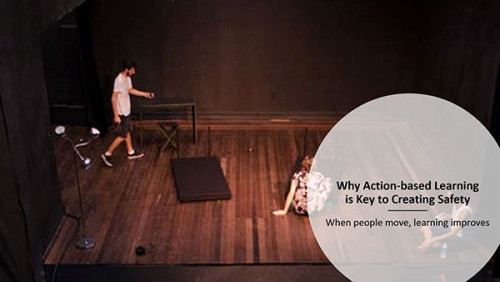Brain research shows that when people move, learning improves. Picture an actor rehearsing lines while pacing back and forth. Action-based learning refers to all learning that is orchestrated by some activity on the part of the learners.
Action-based learning can also be described as kinesthetic, tactile, or physical learning. This is important to note as it is often the preferred learning style of field operations personnel. Put them in a conference room for a day wand watch them grow fidgety and distracted.
Compliance vs. Human Performance
When we think about action-based learning, oftentimes military exercises come to mind: combat drills, joint tactical maneuvering, hostage rescue drills, and other training events. If we step back and consider why these topics are the focus in action-based learning, a key concept comes to the surface. Each exercise provides participants with a hands-on, lived experience which can be called upon quickly during a time of crisis to inform their decision-making.
Conversely, action-based learning can also be a key tool in fostering understanding and adoption of human performance concepts. Case in point: minimum approach distance (MAD). In traditional safety, we train our craftworkers to maintain MAD. If MAD is violated, there may be repercussions, including automatic suspension, without learning opportunities. Instead, in human performance, we help our craftworkers to become better judges of distance through drills, competitions, and what we call at Lewis “learning loops” (i.e., different training activities centered around repetitive topics).
Why Action-based Learning in Vegetation Management
Complex environments, like those found in utility vegetation management, are different than orderly systems (e.g., factory floors). We’re operating in high-risk, highly variable environments akin to the special forces. There are many interdependencies (tree conditions, weather conditions, experience levels and training of personnel, etc.) which—even if we’re following all the rules—can lead to unintended or unpredictable consequences.
Learning to adapt in highly variable environments is critical. For this reason, classroom-based training and traditional change management practices often fail in complex environments. In line clearance, we cannot freeze the environment and interactions are not linear. Instead, fostering a culture of learning by doing is the key to building resilience.
At Lewis Tree Service, learning is field-based and iterative. We try things and learn from them. We take small steps forward and, at times, small steps back. This contrasts greatly from classroom-based training where there’s a strong push from leadership to share human performance concepts but a profound misalignment on how to move to real implementation on the front lines.
Cognitive Dissonance
Anyone who has ever been on a diet understands cognitive dissonance. You wake in the morning with a steadfast commitment to your health. When five o’clock rolls around, you begin to waver because you’re tired, no longer feel like hitting the gym, and prefer making something quick and easy for dinner. Your brain is sending two opposing messages and you’re listening to both.
Cognitive dissonance holds true when testing different human performance tools. It may feel uncomfortable. People will push back. This is a healthy indication that we are entering uncharted territory. This is also the price we pay in the tug-of-war between the pull toward the status quo of old safety and push toward a new frontier. In this push-and-pull world, one-and-done training will always fail. Add to this complexity a labor shortage and industry-wide low retention rates. How do we teach new employees how to make sense of what they’re seeing?
To address this, Lewis has embedded safety researchers and cognitive systems engineers into our operation to understand our work, provide expert advice, and help us learn continuously. And, to the point of this article, we provide ongoing real or simulated experiences to accelerate expertise (again, action-based learning).
Conclusion
Industry-wide, our workplaces are a hidden laboratory of alternative choices. Making the space to practice our craft through action-based learning exercises thereby increasing our understanding of complex environments is the single, most impactful gift we can give. At Lewis, we are using action-based learning to radically transform our safety culture. And we’re having fun in the process! We encourage you to join us.




